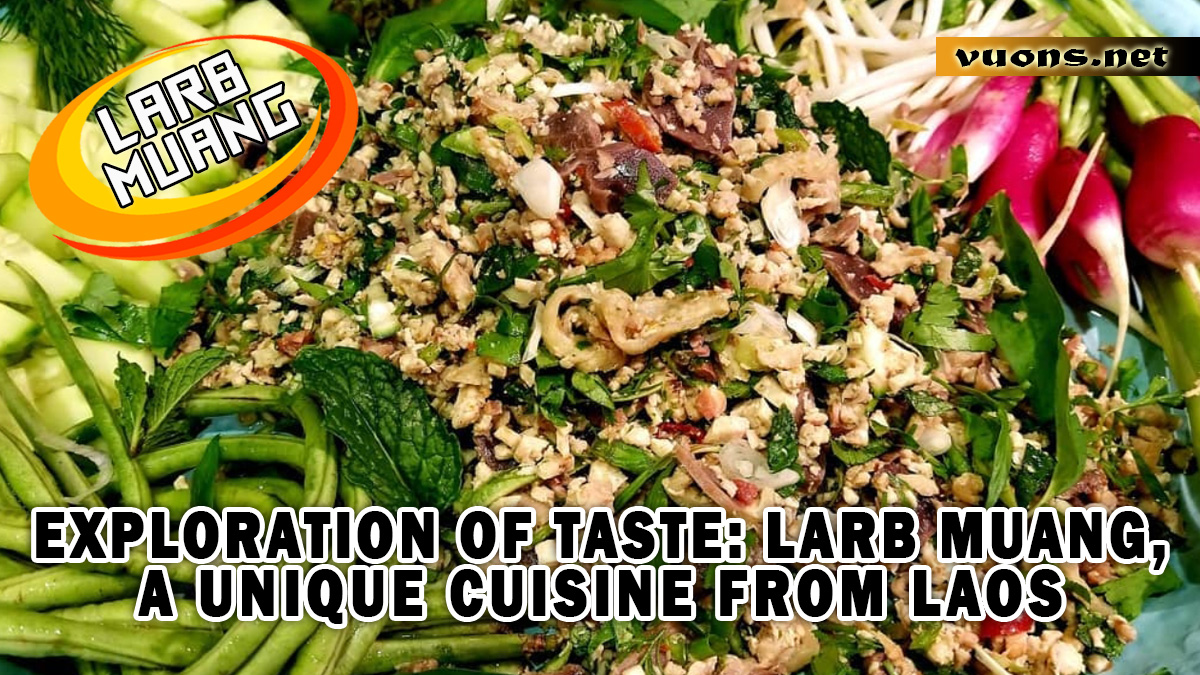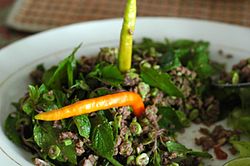Larb Muang: A Symbol of Prosperity in Lao Culture
The Origins of Larb Muang: A Dish Full of Meaning
Larb Muang: A Symbol of Prosperity in Lao Culture – Larb Muang is one of Laos’ signature dishes with deep cultural value. This dish is not only known for its Deliciousness, but also for its deep meaning associated with Laotian traditions. The word “larb” in Lao means good luck or prosperity, so this dish is often served at important events such as weddings, harvest festivals, and other celebrations.
Originating from the northern region of Laos, Larb Muang reflects the diversity of local ingredients available in the area. A combination of minced meat—be it chicken, pork, beef, or fish—is mixed with spices such as mint, cilantro, chili, and lime juice. The addition of ground toasted rice gives a unique texture that enriches the dish.
One of the interesting elements of Larb Muang is its use of sometimes traditional ingredients such as bile or blood, which creates a distinctive authentic taste. This reflects the courage of the Lao people in processing natural ingredients to create a unique and characterful dish.
Larb Muang is also a symbol of togetherness in Laotian culture. This dish is usually served with sticky rice and fresh vegetables, creating a warm moment of family gathering. This uniqueness makes Larb Muang one of the most iconic culinary of Laos, which continues to be preserved from generation to generation.
Traditional Ingredients That Create Authentic Flavors
Larb Muang, one of Laos’ signature dishes, is known for its unique deliciousness. The secret to this authentic taste lies in the traditional ingredients used in its preparation. Each ingredient is carefully selected to create a unique blend of flavors, ranging from sour, savory, to spicy.
Minced meat is the main ingredient of Larb Muang. Usually using chicken, pork, beef, or fish, this meat is processed in such a way that it remains juicy and easily absorbs the spices. The addition of finely ground roasted rice not only adds a fragrant aroma, but also gives a crunchy texture to the dish.
Lime, fish sauce, and chili are mandatory seasonings that provide a balanced sour, savory, and spicy flavor. This combination is the basis of Larb Muang’s distinctive flavor. In addition, fresh herbs such as mint leaves, coriander, and spring onions provide a refreshing aroma and enrich the taste of the dish.
Uniquely, some variations of Larb Muang use additional traditional ingredients such as bile or blood. Although it sounds unusual, this ingredient provides a deeper dimension of taste and reflects the richness of local cuisine.
The use of these traditional ingredients not only provides authentic flavors, but also reflects the Lao people’s connection to nature. By making maximum use of natural resources, Larb Muang has become a symbol of creativity and local wisdom that continues to be maintained to this day.
The Traditional Process of Larb Muang
Larb Muang is a traditional Lao dish that is not only delicious but also reflects the richness of its culture. Its traditional process involves fresh ingredients and unique techniques that have been passed down from generation to generation.
The first step in making Larb Muang is to prepare the minced meat, such as chicken, pork, or beef. The meat is cooked slowly without too much oil to maintain its tender texture. Next, the rice that has been roasted until brown is finely ground to produce a nutty powder, which is one of the essential elements of this dish.
Basic spices such as fish sauce, lime juice, and chili are added to create a distinctive balance of flavors: sour, spicy, and savory. Fresh herbs such as mint, cilantro, and spring onions are mixed in at the final stage to provide a refreshing aroma.
In some traditional variations, additional ingredients such as fresh blood or bile are used to enhance the flavor. Although not always adopted in modern versions, these ingredients reflect the boldness and depth of Lao flavors.
Once all the ingredients are mixed, Larb Muang is usually served with sticky rice and fresh vegetables such as cucumber or lettuce. This dish is often served at family gatherings or traditional ceremonies, making it a symbol of togetherness and prosperity in Lao culture. The simple yet thoughtful process of making it is one of the reasons why Larb Muang remains a favorite today.
The Popularity of Larb Muang in the International Culinary Scene
Larb Muang, a typical dish from Laos, is now increasingly well-known internationally. As one of the representatives of Southeast Asian cuisine, Larb Muang attracts many food lovers because of its complex yet balanced combination of sour, savory, and spicy flavors. This dish is starting to be found frequently in various restaurants serving Asian cuisine in countries such as the United States, Australia, and Europe.
The uniqueness of Larb Muang lies in its fresh ingredients and simple cooking techniques. This has attracted the attention of international chefs who want to explore herbal and spice-based cuisine. Many famous chefs have included Larb Muang in their menus, giving it a modern touch without losing its authentic taste.
Its popularity is also driven by the healthy food trend. With the use of lean meat, fresh herbs, and minimal oil, Larb Muang is considered a healthy yet delicious culinary choice. This combination attracts the attention of those looking for traditional food that suits a modern lifestyle.
Social media has also played a role in introducing Larb Muang to various parts of the world. Brightly colored photos of the dish often go viral on platforms like Instagram and TikTok. Food vloggers and food writers have also helped promote the dish through positive reviews and recommendations.
As Lao cuisine has become more and more influential around the world, Larb Muang has become a symbol of pride for the Lao people. This dish proves that traditional culinary heritage can be accepted and appreciated internationally without losing its original identity.




